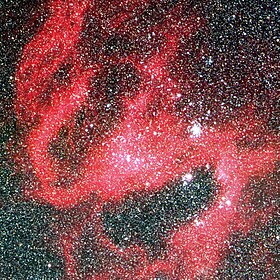S Doradus
| Observation data Epoch J2000 Equinox J2000 |
|
|---|---|
| Constellation | Dorado |
| Right ascension | 05h 18m 14.35s |
| Declination | −69° 15′ 01.10″ |
| Apparent magnitude (V) | 9.565 (8.6 – 11.5) |
| Characteristics | |
| Spectral type | B8/9eq – F0/5:Iae |
| U−B color index | –0.98 |
| B−V color index | +0.11 |
| Variable type | S Doradus |
| Astrometry | |
| Radial velocity (Rv) | +228 km/s |
| Proper motion (μ) |
RA: 0.7 mas/yr Dec.: 4.9 mas/yr |
| Distance | 169,000 ly (51,800 pc) |
| Absolute magnitude (MV) |
–7.6 (1965) –10.0 (1989) |
| Details | |
| Mass |
24+16 −2 M☉ |
| 1989 (maximum) | |
| Radius | 380 R☉ |
| Luminosity | 910,000 L☉ |
| Surface gravity (log g) | 0.6 cgs |
| Temperature | 8,500 K |
| 1985 (minimum) | |
| Radius | 100 R☉ |
| Luminosity | 1,400,000 L☉ |
| Surface gravity (log g) | 1.6 cgs |
| Temperature | 20,000 K |
| 1965 (deep minimum) | |
| Luminosity | 2,000,000 L☉ |
| Temperature | 35,000 K |
| Other designations | |
| Database references | |
| SIMBAD | data |
S Doradus (also known as S Dor) is one of the brightest stars in the Large Magellanic Cloud (LMC), a satellite of the Milky Way. It is a Luminous Blue Variable and one of the most luminous stars known, but so far away that it is invisible to the naked eye.
S Doradus was noted in 1897 as an unusual and variable star, of Secchi type I with bright lines of Hα, Hβ, and Hγ. The formal recognition as a variable star came the assignment of the name S Doradus in 1904 in the Second supplement to Catalogue of Variable Stars.
S Dor was observed many times over the coming decades. In 1924, it was described as "P Cygni class" and recorded at photographic magnitude 9.5 In 1925, its absolute magnitude was estimated at −8.9. In 1933 it was listed as a 9th magnitude Beq star with bright hydrogen lines. It was the most luminous star known at that time.
In 1943, the variability was interpreted as being due to eclipses of a binary companion, orbiting with a period of 40 years. This was refuted in 1956, when the variability was described as irregular and the spectrum as A0 with P Cygni profiles and emission for many spectral lines. The brightness was observed to decline by 0.8 magnitudes from 1954 into 1955. At the same time, S Doradus was noted as being similar to the Hubble-Sandage variables, the LBVs discovered in M31 and M33. The brief 1955 minimum was followed by a deep minimum in 1964, when the spectrum was compared to Eta Carinae in strong contrast to the mid-A spectrum at normal brightness.
By 1969 the nature of S Doradus was still uncertain, considered possibly to be a pre-main-sequence star, but during the next decade the consensus settled on the S Doradus type variables and Hubble-Sandage variables being evolved massive supergiants. They were eventually given the name Luminous Blue Variables in 1984, coined in part because of the similarity of the acronym LBV to the well-defined LPV class of variable stars. The classification system defined for the General Catalogue of Variable Stars pre-dated this and so the acronym SDOR is used for LBVs.
...
Wikipedia

